Everything You Need to Know About Van Heating & Cooling Systems
Learn how to keep your van nice and comfy no matter the time of year.
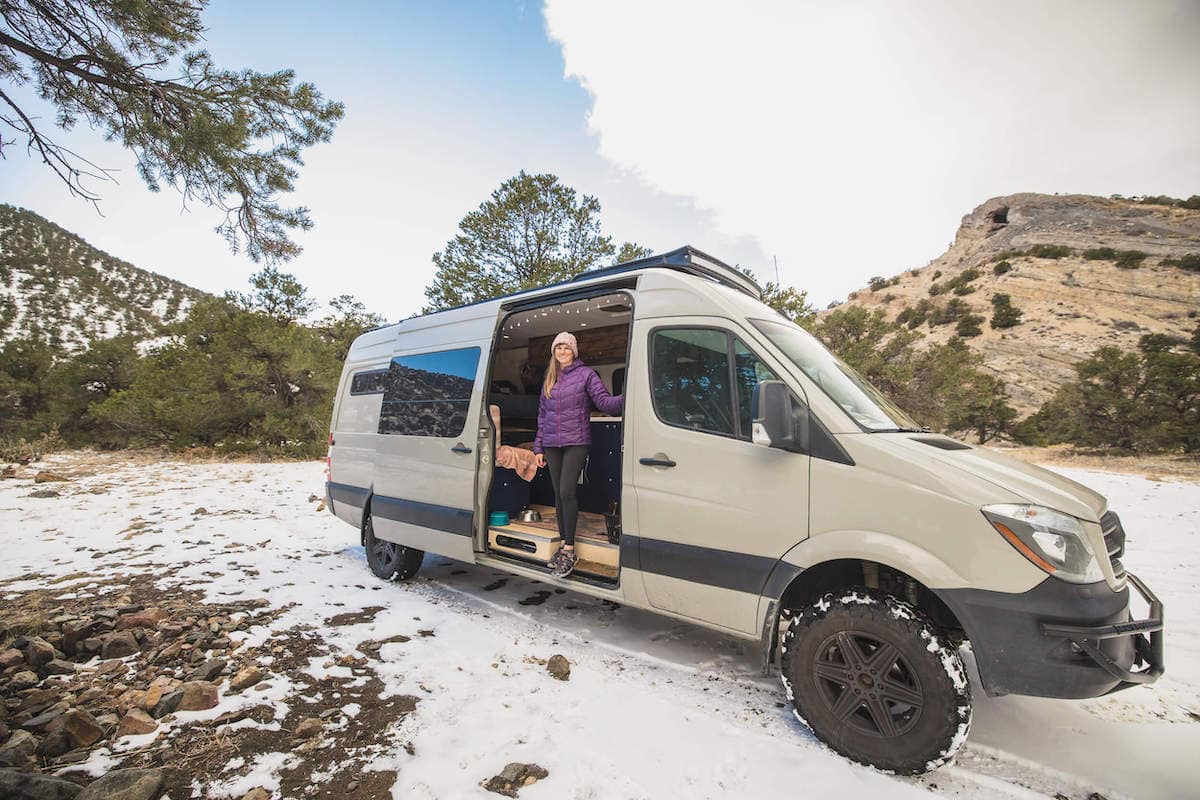
Adequate van heating and cooling systems can make or break a good night’s sleep. No one likes to wake up all sweaty or spend eight hours shivering under the blankets because it’s too cold. If you’re a full-time van lifer, proper temperature control also allows you to camp during times of year (like winter) that you wouldn’t be able to otherwise.
While your van probably has heat and AC that comes out of the dashboard, how do you make the temperature comfortable when the van isn’t running? In this post, I cover different heating options, ceiling fans to keep the interior cool, and the important role van windows play when it comes to temperature control.
1-on-1 Van Life Coaching
Ready to get over your analysis paralysis and put your van life dreams into action? Let’s make it happen together. Book a 1-on-1 van life coaching call now and take the first step towards a life of adventure, freedom, and unforgettable experiences.
Learn all about van heating and cooling basics and how to regulate the temperature no matter where you are.
Importance of Van Heating & Cooling Systems
Even with proper insulation, controlling the interior temperature of a van is key to maintaining a comfortable living space. It’s one thing to spend a single cold night out under the stars, but it’s another thing to be cold every single night in your van.
The same goes for extreme heat – no one wants to be super sweaty climbing into their bed at night, and on a hot, sunny day, you want to be able to take refuge in your van.
Having proper heating and cooling systems in your van is most likely essential depending on where you plan on traveling.
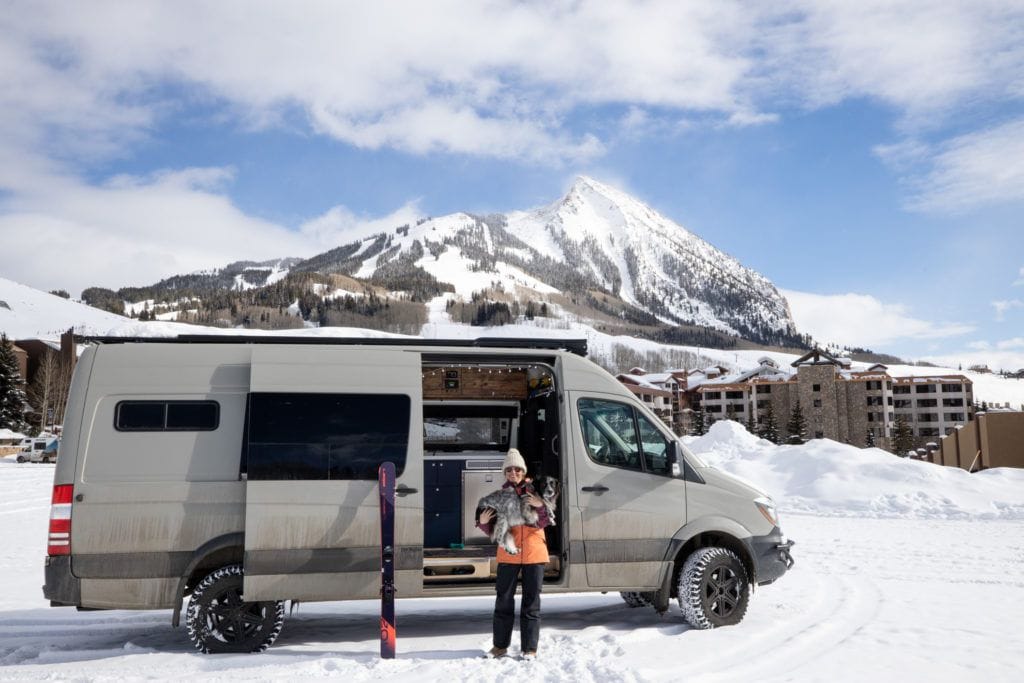
Best Van Heating Options
If you’ll be traveling to places that get pretty cold, you’ll want to consider installing a heater in your van. A heater is also important for ensuring your water pipes don’t freeze when temperatures drop below 32 degrees. No matter what heater you choose, I do suggest getting a carbon monoxide detector with an alarm so you will be alerted of any leaks while you sleep.
If you’re looking to install a heater, there are four main types to consider
- Portable propane heaters
- Fixed propane heaters
- Electric heaters
- Diesel/gasoline heaters
Portable Propane Heaters
Portable propane heaters, like Mr. Heater Buddy, are popular with van lifers because they are inexpensive, easy to use, require no installation, and you can connect them to the same propane tank you use to cook with or use small 1lb propane canisters. They heat a small space quickly and can be easily stored when you don’t need them, but there are a few downsides.
Propane heaters tend to result in condensation, so you’ll want good airflow throughout your van. Additionally, many people are uncomfortable having open propane inside their vehicle, particularly while they sleep. A faulty, leaking propane tank releases carbon monoxide into the air, which can be deadly if you don’t catch it right away, yet another reason you’ll want good airflow.
Tips for using a Buddy Heater:
- Do not use while sleeping. Heat your van, and turn off the heater before you go to sleep.
- Crack your windows to prevent condensation and carbon monoxide leaks.
Fixed Propane Heaters
Another option is to install a fixed propane heater, like a Propex. These produce less condensation and work well in cold temperatures. A fixed propane heater requires a bit more installation work and typically the propane tank is vented to the outside, reducing the carbon monoxide safety concerns.
Electric Heaters
Electric heaters are only suitable if you’re running on a generator or plugged into shore power. Electric heaters – and this includes electrical blankets – are taxing on a solar-powered power system due to how much power they pull, but otherwise, they’re inexpensive, lightweight, quiet, and will heat a small space well.
My sense is that you’re likely here because you want to get off the grid, and in that case, electric heaters will not be the best option for you.
Diesel/Gasoline Heaters
Diesel heaters work by siphoning a small amount of fuel from your vehicle’s fuel tank. They are a heftier investment upfront but are very efficient over time. In fact, some brands are reported to burn only a gallon of fuel for every 20-50 hours of use.
Espar and Webasto make the most popular diesel heater models and they are both quite small and compact. A popular place to install this type of heater is under the passenger seat.
Diesel heaters can get noisy, which is something to be aware of if stealthiness is your top priority. In this case, you should consider installing a muffler to reduce noise.
Some models of diesel heaters will also heat water. I had the Webasto Dual Top Evo 6 in my second van which did this.
If you don’t have a diesel van, Espar and Webasto both make gasoline-powered heaters as well. If you don’t want to tap directly into your vehicle’s fuel tank, another idea is to keep fuel for your heater in a separate, secure tank built into your van and tap from there.
How Windows & Curtains Affect Temperature Control
Van Windows
Vans with a lot of windows look beautiful and it’s easy to be wooed by pretty photos. Who wouldn’t want a 360 view from inside their van? However, windows come with a downside that is important to be aware of when considering your van heating and cooling strategy.
With windows, you lose insulation. For my second van, this is why I opted against installing windows on the rear door. With rear windows, depending on the layout of your bed, heat escapes right where your head is which is kind of a double whammy. Plus, with a raised platform bed, part of the window may dip below the bed frame, rendering the bottom part of the window useless.

Van Curtains
Additionally, the more windows you have, the more curtains you’ll need which is something people often overlook. Depending on your window trim, you can use magnets, velcro, or snaps to secure curtains to the wall. If a view is more important, we get it – but keep these other details in mind.
Unless you sew them yourself, curtains – especially those that insulate – can be very expensive. Some even run upwards of $1500 or more for a full set of insulating, blackout curtains that help control temperature and offer maximum privacy.
The curtains in my second van were made by Outside Van. They were made of ripstop nylon with a layer of closed-cell foam on the interior which gave them insulating properties. I noticed that they were very effective at controlling hot and cold air transfer through the windows.
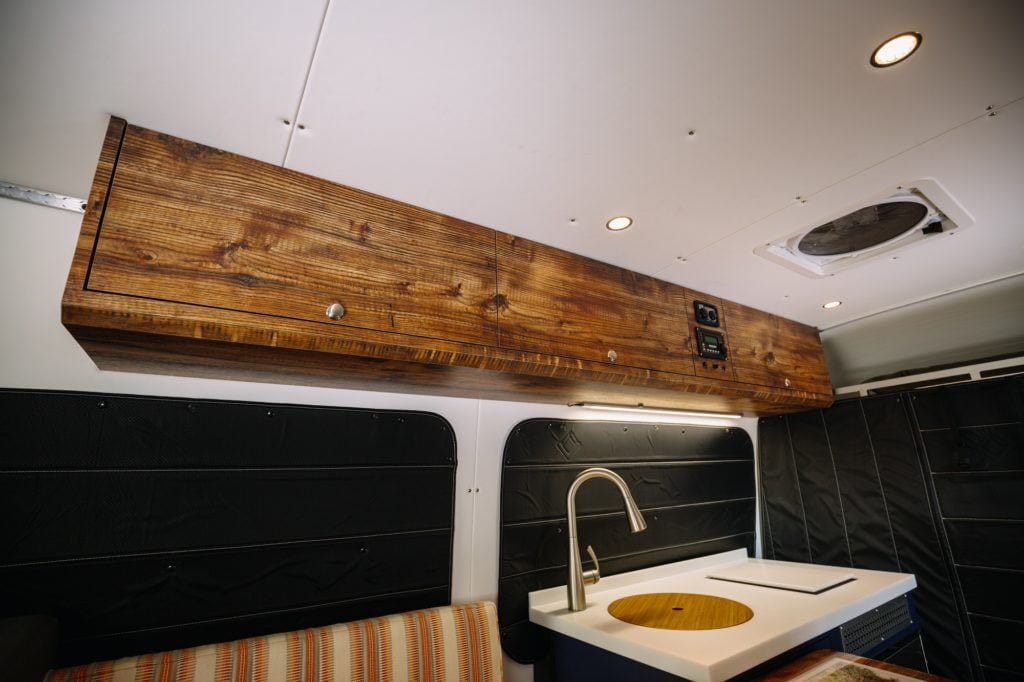
In hindsight, in my next van, I will likely reduce the total number of windows even further to control temperature and keep our privacy. We also lost storage space along the walls because of all of the windows. Next time, I’ll probably keep the windows I have upfront near the slider door, but I’d get rid of the middle row.
Factory windows vs aftermarket windows
A final thing to note is the difference between factory windows and aftermarket windows. Factory windows, at least on Sprinter Vans, do not open or vent. That’s why you see many people either adding or replacing factory windows with aftermarket ones. CL Laurence and AMA are two popular companies that make vented, after-market windows for campervans.
Ceiling Fans & Van Air Conditioning
Ceiling fans
In order to keep your van cool in the summer as well as to prevent condensation in your van in the winter, I highly recommend installing 1 or 2 ceiling fans, depending on the length of your vehicle.
In the 170” Sprinter Van, 2 fans work great. We have one over our galley and another over the bed. If we have one fan pulling air in and the other blowing air out, we can get really decent airflow, especially if we have a window or two open.
By planning our route to avoid super hot climates – like the Southern Utah desert in the summer – we’ve never felt the need to have an additional rooftop air conditioning unit in the van.
The two most popular brands for fans are Maxx Air and Fantastic Fan. When searching for the right fan, some of the features you’ll need to think about are:
- Whether you want a rain cover
- If you want a remote control
- The number of fan speeds
- The price point that fits into your budget
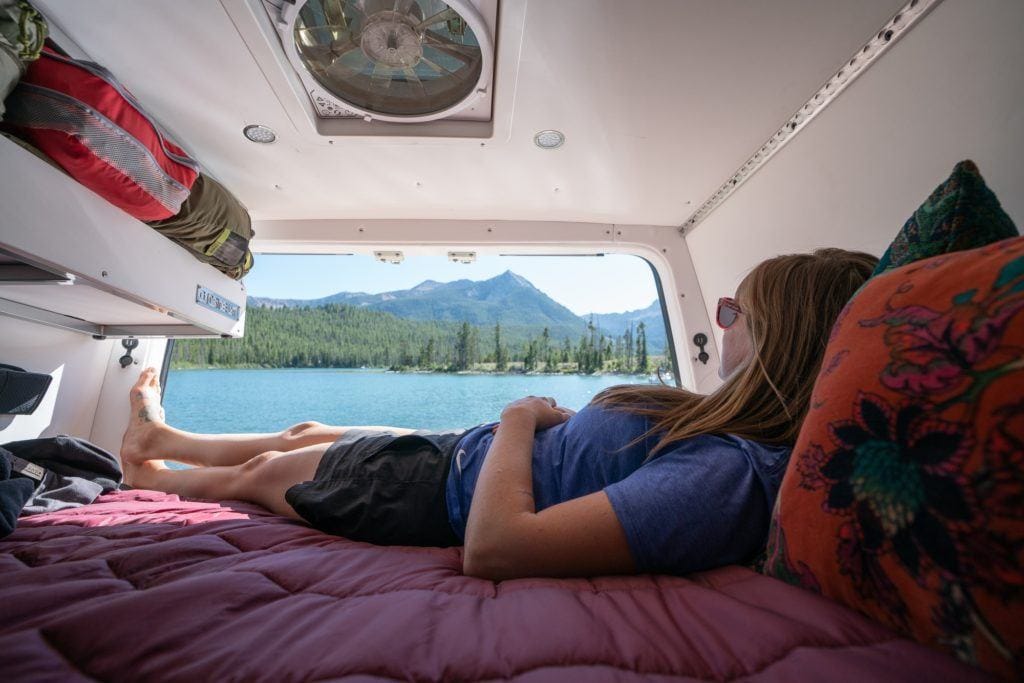
Van Air Conditioning
By installing a couple of fans, having windows that open, using quality insulation, and having insulating window curtains, you will go a long way in making the temperature inside your van comfortable. By avoiding the hottest places in the hottest months of the year, you can eliminate the need for an additional air conditioning unit in your van.
If you do want to install an additional van airconditioning unit, know that you will either need a generator, an extremely robust power system, or frequent access to shore power. Even then, AC units consume a ton of juice and you won’t be able to run it 24/7. With a big battery bank, you might be able to run the AC for a few hours at a time, but then you’ll need to find a way to charge up.
For this reason, I’m not going to go into more detail about AC units, but for those of you who really do want one, I’ll include some helpful links in the resources section below.
Van Heating & Cooling Resources Section
- Mr. Heater Buddy – A portable propane heater
- Heatso.com – A marketplace for fuel-powered heaters including Espar and Webasto models
- DIY Espar Diesel Heater Install Video – A step-by-step video by Ray Outfitted
- Van Windows Direct – A marketplace for aftermarket van windows
- Maxx Air ceiling fan & Fantastic Fan – Two popular options for van ceiling fans
- Battery-powered air conditioner review – A video by Seven O Savage
- 12V Battery-Powered AC For Off-the-Grid Van Life – A review by Far Out Ride

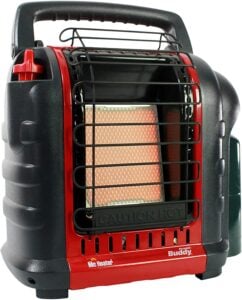


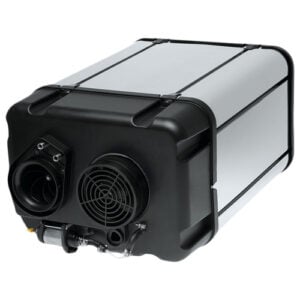

Hi you can buy 12volt electric blankets off the internet that don’t use much power and work quiet well for around $30 australian I use them here in Tasmania our average temperature in winter is -5 degrees cel, and i live in a toyota coaster camper full time and im going to install a diesel heater and a bobil water heater soon
HEAT: I bought and use a 12 volt heating blanket all night long, never drains my batteries too low. I also run a gas Webasto heater. and cannot believe how comfortable my van is to hang out in during the middle of terrible storms and cold weather.
COOLING: I have the medium length Transit and added 2 Maxx Air fans with 10 speeds to choose from, plus the ability to bring air in or push air out. They work well by themselves but really make a difference working in conjunction with 4 Motion windows that I added into my build- all slide open and come with screens.
HEAT and COOL: I used a ton of great insulation, Thinsulate by 3M. The game changer for me was purchasing insulated, magnetic window coverings from Vanmade Gear. Not only are the Vanmade Gear window coverings super easy to cover windows using magnets, but most of mine store on the windows or above them folded up when not in use. A variety of options for using part of the shade or all of it b/c they magnet to themselves. I travel with an 18 year old cat and the insulated shades control the temperature in the van better than any other feature of my van. They are also black out, so it is nice to be able to fold down a panel or two to let in light but retain privacy. I have seen many people refer to them as expensive. I can only say that they last forever and have brought so much comfort to my van, they are worth every penny and I find myself appreciating them on every single trip I take.
Hi Jeri, thanks for sharing your heating & cooling setup – it sounds really efficient & I’m sure it will help others looking for what to do in their van!
I like the 12v electric blanket idea, need to get one. I currently have chinese diesel heater and rarely turn it on since it get to warm for us and dry out the air. As mention here, window looks good but its doesn’t help with heat or cold insulation. But you still need a vent or window in the back for cross ventilation.
If you live in dry climate, a DIY swamp cooler that attach to maxxair fan is a good cheap optioin if roof top A?C is out of your budget:
Detail on the DIY fan cooler
https://www.promasterforum.com/threads/fantastic-vent-cooler.50722/
One thing help us with the heat is installing clear tint (llumar Air or 3m Crystalline) on all front window and windshied which help cut down a lot of heat while we are driving. It feel 10-15 degree cooler and I can tell how hot the sun burn my skin when I have my window down. Since the tint is mostly clear, it doesn’t effect night driving. We were super happy with the tint when we drove through Death Valley when it was 130+ outside.